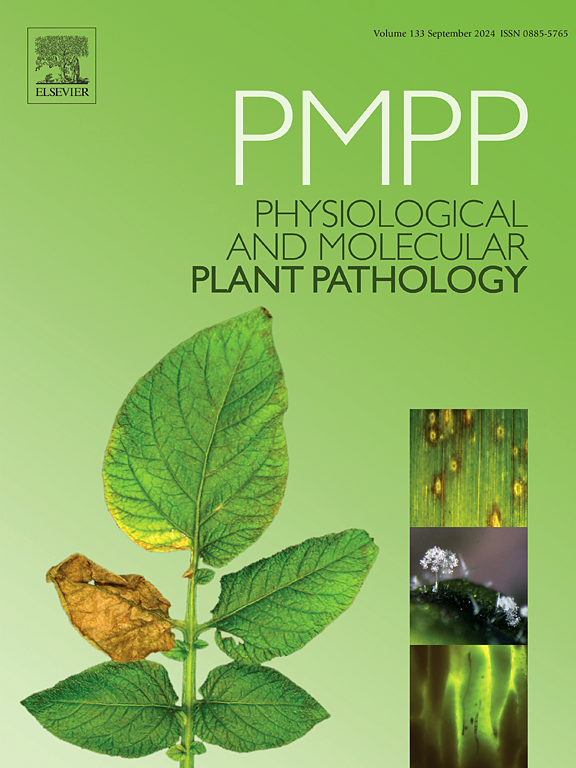Synthesis and role of nanoparticles as immunomodulators against plant biotic stress: Insights into Fusarium wilt management
IF 2.8
3区 农林科学
Q2 PLANT SCIENCES
引用次数: 0
Abstract
Global population outburst, xenobiotic activity and rapid urbanization challenges agricultural production heavily. Moreover, biotic stress caused by diverse group of pathogens subdued the crop yield dramatically. Among different pathogens, Fusarium oxysporum is a prominent pathogen of cosmopolitan distribution responsible for wilt disease. The fusarial wilt accounts for severe (10–100 %) yield loss for which global agricultural market faces huge economic losses. Scientists constantly tried to contain the wilt disease effectively in multifaceted approach. Most of the work concentrated towards resistance development through genetic manipulation or breeding with the resistant background. Although, effective but due to rapid mutation capability of the pathogen and gene segregation in plants; resistance losses in subsequent generations naturally. Similarly, chemical fungicides are also widely used, tolerance to the particular chemical fungicides gradually diminishes their effectivity. In such situation nanoparticles have emerged as one of the potent alternatives due to their unique chemistry and wonderful biological activities. The nanoparticles can be synthesized chemically or biologically. Due to their high reactive nature and activity in very low concentration, there are minimum ecological, environmental and non-specific biological toxicity. Biosynthesized nanoparticles are further safe and revolutionized the plant immunochemistry immensely. Recently, the direct interaction of nanoparticles with the plant immune response has also been documented. Hence, the present review sheds light on the unique immunomodulatory effect of nanoparticles during plant biotic stress and also comprehensively analyses its potential role in Fusarium wilt management. The review not only highlights different approaches of synthesis, application and delivery of nanoparticles against pathogen with the special reference to Fusarium oxysporum, it also envisages relevant research questions to shape the future direction of the related study.
纳米颗粒作为植物生物胁迫免疫调节剂的合成和作用:枯萎病管理的见解
全球人口激增、外来生物活动和快速城市化给农业生产带来了严峻挑战。此外,多种病原菌引起的生物胁迫显著降低了作物产量。在不同的病原菌中,尖孢镰刀菌(Fusarium oxysporum)是一种世界性的重要病原菌。枯萎病造成严重的(10 - 100%)产量损失,使全球农业市场面临巨大的经济损失。科学家们一直试图从多方面有效地控制黄萎病。大多数工作集中在通过基因操作或具有抗性背景的育种来发展抗性。虽然有效,但由于病原菌的快速突变能力和基因在植物中的分离;抗性自然会在后代中丧失。同样,化学杀菌剂也被广泛使用,对特定化学杀菌剂的耐受性逐渐降低其有效性。在这种情况下,纳米粒子因其独特的化学性质和奇妙的生物活性而成为一种强有力的替代品。纳米颗粒可以用化学或生物方法合成。由于其高反应性和极低浓度的活性,具有最小的生态、环境和非特异性生物毒性。生物合成的纳米颗粒更加安全,极大地改变了植物免疫化学。最近,纳米颗粒与植物免疫反应的直接相互作用也被证实。因此,本文综述了纳米颗粒在植物生物胁迫中的独特免疫调节作用,并对其在枯萎病防治中的潜在作用进行了综合分析。本文综述了以尖孢镰刀菌为代表的纳米颗粒抗病原菌的合成、应用和递送的不同方法,并展望了相关的研究问题,以确定相关研究的未来方向。
本文章由计算机程序翻译,如有差异,请以英文原文为准。
求助全文
约1分钟内获得全文
求助全文
来源期刊
CiteScore
4.30
自引率
7.40%
发文量
130
审稿时长
38 days
期刊介绍:
Physiological and Molecular Plant Pathology provides an International forum for original research papers, reviews, and commentaries on all aspects of the molecular biology, biochemistry, physiology, histology and cytology, genetics and evolution of plant-microbe interactions.
Papers on all kinds of infective pathogen, including viruses, prokaryotes, fungi, and nematodes, as well as mutualistic organisms such as Rhizobium and mycorrhyzal fungi, are acceptable as long as they have a bearing on the interaction between pathogen and plant.

 求助内容:
求助内容: 应助结果提醒方式:
应助结果提醒方式:


